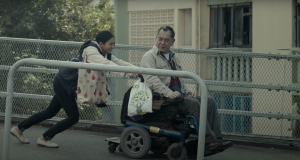STILL HUMAN, DIR. CHAN SIU KUEN (2018)
OI MAN ESTATE, Ho Man Tin, Hong Kong
“Still Human” is about the relationship between a disabled, paralyzed man in a wheelchair, Leung Cheong-wing, and a Filipino domestic worker, Evelyn Santos. Leung Cheong-wing is a hopeless man who has a fragmented family where his son is living in another country and claims that he does not have any dreams and is just a loser, whereas Evelyn was a former nurse who has put her dream of being a photographer on hold and came to Hong Kong to earn a living as a domestic worker. Through living together and learning from one another, they became supportive of each other, Leung Cheong-wing supported Evelyn and helped make her dream of being a photographer true; Evelyn knew Leung’s dream was to go on a graduation trip with his son, so she helped him by bringing his son home.
This film was set in Oi Man Estate in Ho Man Tin, by comparing and contrasting how the buildings and place are presented in the film and how it is seen in and experienced in reality, it can be seen that there are both similarities and difference. I will focus on the similarities and differences of Chung Hau Street, where the iconic scene of Evelyn pushing Leung downhill because she forgot to charge his wheelchair.
Firstly, the look and view of the street and the building at the back of the shot were identical, the trees and buildings were clearly seen in both the movie and in reality. Moreover, in the film, one of the objects that Evelyn took pictures of, were the flowers on the trees. And in reality, the flowers were present as well. However, in the film, it can be seen that as the closer Evelyn and Leung got, a warmer tone was applied to the scenes. It is used to represent the close, happy relationship between Leung and Evelyn, and it also represents hope. From previous scenes of Evelyn standing at the back of Leung’s wheelchair and going downhill, where they were just getting along, a slightly colder tone was applied to the scene, but as their relationship evolved, and they were helping and taking care of each other, a warmer tone was applied. This technique is used to help with the presentation of their relationship and the changes in their attitude towards their lives, hopes, and dreams. Another difference is that, from the film, it can be seen that there were not many cars or people on the street and the surrounding environment was quiet and peaceful, so the scenes can be focused on Leung and Evelyn. However, in reality, because the location of Chung Hau Street is next to Oi Man Plaza, and the bus terminal and next to a few schools, the street is parked by a number of cars, and that there are many buses, minibusses, taxis on the street, a lot of noise produced by people and cars can be heard. These are the similarities and differences of the location.
— Woo Sik Yu Sonia, 3035797365


Left: View of Chung Hau Street next to Oi Man Estate. Scenes from Still Human, 2018, directed by Chan Siu Kuen. Right: Picture of the street taken by me

View of Chung Hau Street next to Oi Man Estate. Scenes from Still Human, 2018, directed by Chan Siu Kuen.
The above link is the video of Chung Hau Street taken by me
Notes;
- Produced by No Ceiling Film, the film was directed by Chan Siu Kuen and starred Hong Kong actor Anthony Wong. It was released in Hong Kong in November 2018.
Focusing on Chung Hau Street could benefit you from analysing a specific site through different perspectives. You pointed out how the colour tone changes in the film represented the emotional distance between two protagonists. Would you think space also be utilised to express those tensions in a film? In what way spaces could perform as more than just a film set? With regard to the comparison of the set vs real, you could also expand on what was likely to be achieved by a “staged” set where no one is around except the two protagonists? (see also: mise-en-scène). Adding more images to your analysis could help readers to follow through with your argument as well. Consider using one of the key ideas we have discussed in the class to read through the site and build your argument. As for the images, recreating a scene shot would be one of the ways to situate your fieldwork photos. This way you can compare how space is portrayed and appropriated in film and in real life. Also, remember to cite any others’ works you referred properly. This would include, but not limited to, texts, images and/or videos.